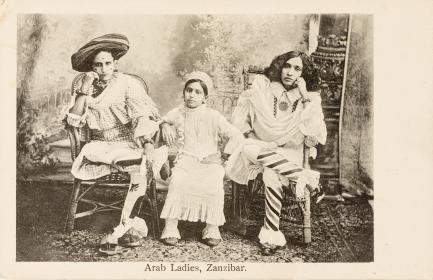
Arab Ladies, Zanzibar
A.C. Gomes and Son
Postcard, collotype
Zanzibar, c. 1910
Courtesy the Eliot Elisofon Photographic Archives
National Museum of African Art, Smithsonian Institution
The Smithsonian’s National Museum of African Art is launching the online exhibition “Sailors and Daughters: Early Photography and the Indian Ocean World.” The event is part of the museum’s multiyear series of programming, Connecting the Gems of the Indian Ocean: From Oman to East Africa, made possible by a $1.8 million gift by the Sultan Qaboos Cultural Center in Washington, D.C. The online exhibition brings together early photographs, albums and related media from the region to a digital audience; photography was part of the flow of people, ideas and technologies crossing the western Indian Ocean at the turn of the last century. The exhibition was commissioned by the museum and curated by Erin Haney.
“The National Museum of African Art is pleased to bring these photographic treasures to a global audience with our first online exhibition,” said Nicole Shivers, the museum’s education specialist for performing arts and project lead. “We hope that it will inspire new reflections on the rich and interconnected artistic cultures of this region, which embraced photography from its very beginnings.”
“This exhibition highlights the vivid imagery of the urban maritime societies of Zanzibar, the east African coast and interior, and their ties to Oman, the Persian Gulf and the Indian Ocean islands,” said Haney. “We’ve assembled little-known and rare collections of early photographs, lithographs, postcards and private albums created by an array of notable cosmopolitan artists. It’s an exciting step towards a larger appreciation of these modern photographic traditions.”
Exhibition Highlights
Support
Lending partner institutions include the museum’s Eliot Elisofon Photographic Archives and the Warren M. Robbins Library; the Melville J. Herskovits Library of African Studies Winterton Collection at Northwestern University; the Stephen Arpee Collection of Sevruguin Photographs at the Smithsonian’s Freer Gallery of Art and Arthur M. Sackler Gallery Archives; Archives départementales de La Réunion and Iconothèque de L’Océan Indien at the Seychelles National Archives; and the Ethnologisches Museum at the Staatliche Museen zu Berlin. The exhibition design is by Wilcox Design/Green Interactive. It is supported by the gift of $1.8 million from the Sultan Qaboos Cultural Center in Washington, D.C.
About the Curators
The exhibition was developed by Haney with research assistance by Xavier Courouble. It is part of the program series Connecting the Gems of the Indian Ocean: From Oman to East Africa.
Online Exhibition Presentation, Film Screening and Reception April 18
Haney will give a presentation of the online exhibition followed by a reception and film screening of African Lens, The Story of Priya Ramrakha, from noon to 3 p.m. in the museum’s Lecture Hall. The film, by Shravan Vidyarthi, is about the life of the late Kenyan photographer Priya Ramrakha, who became prominent worldwide and was instrumental in showcasing African photography. Ramrakha died while reporting on the Nigerian civil war. The event is free and open to the public.
Educational Programs
Public programs will accompany the exhibition to engage the museum’s diverse audiences from K–12 to adult.
About the National Museum of African Art
The National Museum of African Art is the nation’s premier museum dedicated exclusively to the collection, conservation, study and exhibition of Africa’s traditional and contemporary arts. The museum is open daily from 10 a.m. to 5:30 p.m. (closed Dec. 25). Admission is free. The museum is located at 950 Independence Ave. S.W., near the Smithsonian Metrorail station on the Blue and Orange lines. For more information, call (202) 633-4600 or visit the National Museum of African Art’s website. For general Smithsonian information, call (202) 633-1000.
Note to Editors: Selected images from “Sailors and Daughters: Early Photography and the Indian Ocean World” may be downloaded by visiting the museum’s media website and clicking on “press room.” For media requests, contact Eddie Burke at (202) 633-4660 or burkee@si.edu.
# # #
SI-61-2015